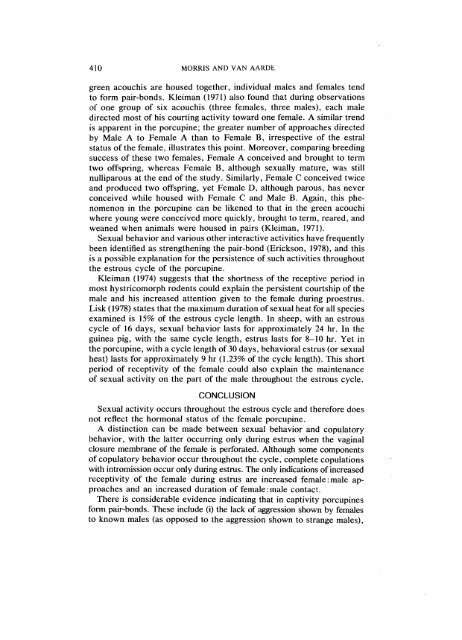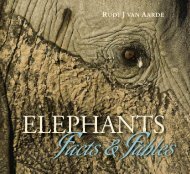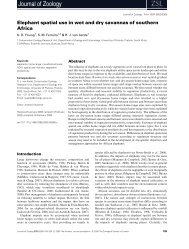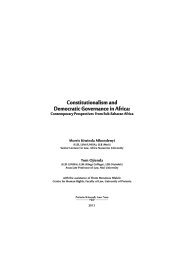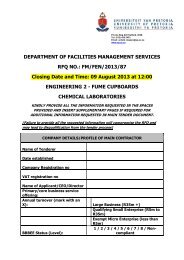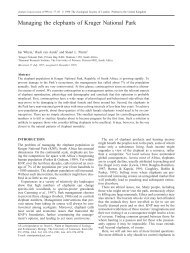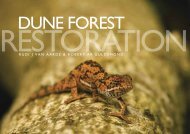Sexual Behavior of the Female Porcupine Hystrix ... - CERU
Sexual Behavior of the Female Porcupine Hystrix ... - CERU
Sexual Behavior of the Female Porcupine Hystrix ... - CERU
Create successful ePaper yourself
Turn your PDF publications into a flip-book with our unique Google optimized e-Paper software.
410 MORRIS AND V AN AARDEgreen acouchis are housed toge<strong>the</strong>r, individual males and females tendto form pair-bonds. Kleiman (1971) also found that during observations<strong>of</strong> one group <strong>of</strong> six acouchis (three females, three males), each maledirected most <strong>of</strong> his courting activity toward one female. A similar trendis apparent in <strong>the</strong> porcupine; <strong>the</strong> greater number <strong>of</strong> approaches directedby Male A to <strong>Female</strong> A than to <strong>Female</strong> B, irrespective <strong>of</strong> <strong>the</strong> estralstatus <strong>of</strong> <strong>the</strong> female, illustrates this point. Moreover, comparing breedingsuccess <strong>of</strong> <strong>the</strong>se two females, <strong>Female</strong> A conceived and brought to termtwo <strong>of</strong>fspring, whereas <strong>Female</strong> B, although sexually mature, was stillnulliparous at <strong>the</strong> end <strong>of</strong> <strong>the</strong> study. Similarly, <strong>Female</strong> C conceived twiceand produced two <strong>of</strong>fspring, yet <strong>Female</strong> D, although parous, has neverconceived while housed with <strong>Female</strong> C and Male B. Again, this phenomenonin <strong>the</strong> porcupine can be likened to that in <strong>the</strong> green acouchiwhere young were conceived more quickly, brought to term, reared, andweaned when animals were housed in pairs (Kleiman, 1971).<strong>Sexual</strong> behavior and various o<strong>the</strong>r interactive activities have frequentlybeen identified as streng<strong>the</strong>ning <strong>the</strong> pair-bond (Erickson, 1978), and thisis a possible explanation for <strong>the</strong> persistence <strong>of</strong> such activities throughout<strong>the</strong> estrous cycle <strong>of</strong> <strong>the</strong> porcupine.Kleiman (1974) suggests that <strong>the</strong> shortness <strong>of</strong> <strong>the</strong> receptive period inmost hystricomorph rodents could explain <strong>the</strong> persistent courtship <strong>of</strong> <strong>the</strong>male and his increased attention given to <strong>the</strong> female during proestrus.Lisk (1978) states that <strong>the</strong> maximum duration <strong>of</strong>sexual heat for all speciesexamined is 15% <strong>of</strong> <strong>the</strong> estrous cycle length. In sheep, with an estrouscycle <strong>of</strong> 16 days, sexual behavior lasts for approximately 24 hr. In <strong>the</strong>guinea pig, with <strong>the</strong> same cycle length, estrus lasts for 8-10 hr. Yet in<strong>the</strong> porcupine, with a cycle length <strong>of</strong>30 days, behavioral estrus (or sexualheat) lasts for approximately 9 hr (1.23% <strong>of</strong> <strong>the</strong> cycle length). This shortperiod <strong>of</strong> receptivity <strong>of</strong> <strong>the</strong> female could also explain <strong>the</strong> maintenance<strong>of</strong> sexual activity on <strong>the</strong> part <strong>of</strong> <strong>the</strong> male throughout <strong>the</strong> estrous cycle.CONCLUSION<strong>Sexual</strong> activity occurs throughout <strong>the</strong> estrous cycle and <strong>the</strong>refore doesnot reflect <strong>the</strong> hormonal status <strong>of</strong> <strong>the</strong> female porcupine.A distinction can be made between sexual behavior and copulatorybehavior, with <strong>the</strong> latter occurring only during estrus when <strong>the</strong> vaginalclosure membrane <strong>of</strong> <strong>the</strong> female is perforated. Although some components<strong>of</strong> copulatory behavior occur throughout <strong>the</strong> cycle, complete copulationswith intromission occur only during estrus. The only indications <strong>of</strong> increasedreceptivity <strong>of</strong> <strong>the</strong> female during estrus are increased female: male approachesand an increased duration <strong>of</strong> female: male contact.There is considerable evidence indicating that in captivity porcupinesform pair-bonds. These include (i) <strong>the</strong> lack <strong>of</strong> aggression shown by femalesto known males (as opposed to <strong>the</strong> aggression shown to strange males),


